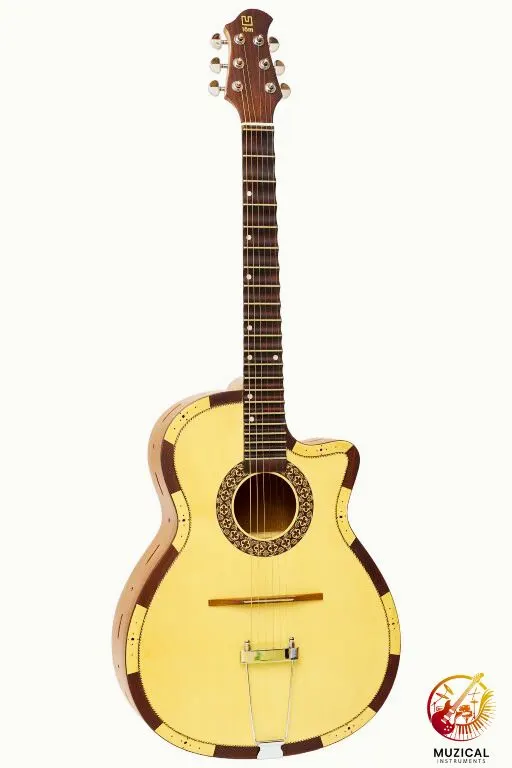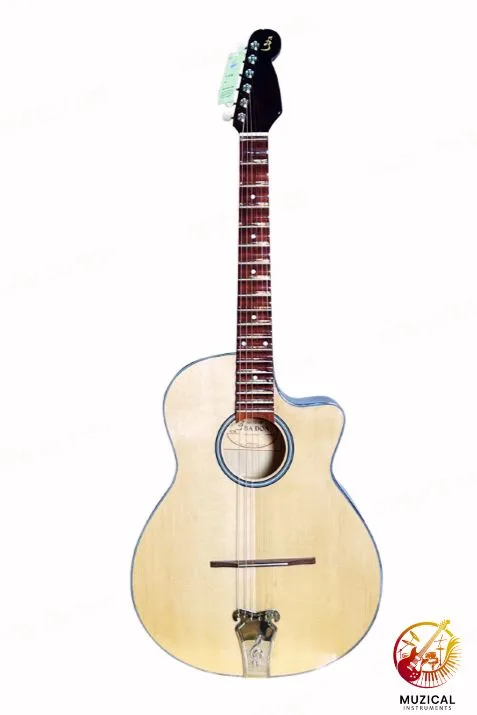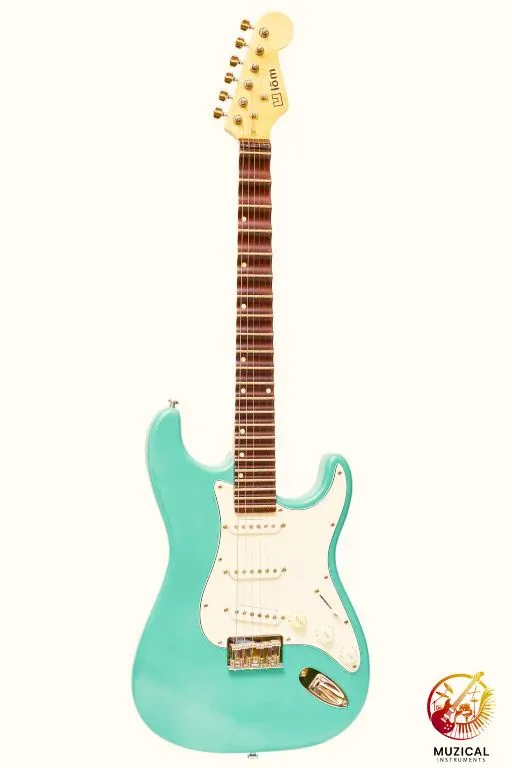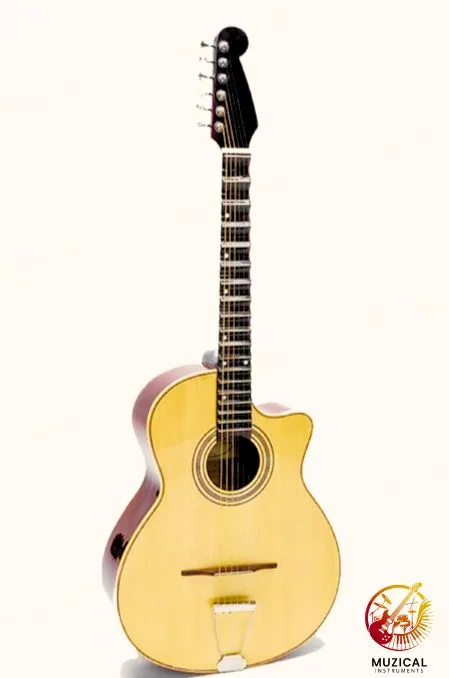What Is a Vietnamese Guitar Called? Discover the Secrets of the Scalloped Fretboard Instrument
The Vietnamese guitar is called the Guitar Phím Lõm, a name that literally means “guitar with sunken frets.” Unlike the guitars you may have seen or played, this one has scalloped spaces carved out between the frets. It isn’t just a cosmetic change, it’s a vital feature that allows Vietnamese musicians to hit the bending, expressive notes central to the country’s cải lương (Southern opera) tradition.
This isn’t your usual guitar. The Guitar Phím Lõm may have come from the West, but Vietnam made it its own. With deep, sliding notes that almost sound like a voice crying, this instrument tells stories no regular guitar could ever tell.
In this article, you’ll learn:
- What makes this Vietnamese guitar so special
- Where it came from and how it evolved
- How it’s played, and what other Vietnamese string instruments share the stage
- Whether you can try one yourself
Ready to explore the sound that defines Southern Vietnam’s heart? Let’s dive in.
What Makes the Vietnamese Guitar Phím Lõm Unique?
At first glance, the Vietnamese guitar, Guitar Phím Lõm looks like a regular six-string guitar. But look closer at the neck, and you’ll see something strange. The wood between the frets is scooped out, curved like a shallow bowl. That curve is what gives the Guitar Phím Lõm its voice.


Why the Frets of Vietnamese Guitars Are Scalloped
When a luthier carves out the fingerboard wood between frets, it lets your fingertip press the string deeper, not flatter. This means you can bend notes up or down microtonally, by tiny steps creating weeping slides and vibratos you won’t hear on a Western guitar.
Unlike a standard guitar, where frets act like strict borders, the scalloped spaces in a Vietnamese guitar let you glide across emotional terrain. It’s almost like combining a guitar with a fretless violin or even a theremin.
Comparison Table: Standard Guitar vs. Guitar Phím Lõm
| Feature | Standard Guitar | Guitar Phím Lõm |
|---|---|---|
| Fretboard | Flat | Scalloped between frets |
| String Bending | Limited to 1–2 semitones | Up to 3+ semitones, microtones |
| Playing Style | Press frets | Pull into scallops, vibrato-heavy |
| Sound Character | Clean, precise | Wavy, expressive, crying-like |
| Primary Use | Western genres | Cải lương, Vietnamese opera |
How Did It Emerge in Southern Vietnam?
In the late 1800s, French colonizers brought classical guitars to Vietnam. But local musicians didn’t just copy what they saw, they changed it.
They took the six-string instrument and modified the fretboard to serve vọng cổ (nostalgia songs). These were deeply emotional tunes full of sliding and bending melodies. Standard frets couldn’t capture that raw emotion. So Vietnamese players carved out the fretboard, letting them dip into notes the French never imagined.
Over time, this evolved into the modern Guitar Phím Lõm, rooted in the folk theater known as cải lương. In these live performances, the guitar isn’t just background music, it acts like a singing partner to the actor.
Cải lương translates to “renovated theater,” but it’s more than that. It’s a blend of traditional Vietnamese drama and Western harmony, and the guitar sits right in the middle of that blend.
Cultural Insight
In Southern Vietnam, this guitar became more than a novelty, it became the sound of heartbreak, love, longing, and rural storytelling.
What Techniques Do Players Use?
You can’t play a Vietnamese guitar (Guitar Phím Lõm) the same way you play your steel-string at home. Here’s why:


Microtonal Bending
Instead of just pressing down on a fret, you pull or push the string deeper into the scallop. This stretches the pitch gradually. Think of it like singing a note and sliding into another, it’s smooth, fluid, and emotional.
Vibrato
With those deep scallops, vibrato becomes wavy and wild. You can mimic the human voice or even the Vietnamese đàn bầu (a one-string instrument famous for its tremolo).
Playing Tip
Want to try the feel? On your Vietnamese guitar, very lightly place a finger between two frets. Slide it while plucking the string. Now imagine being able to bend that note while keeping the string in one spot, that’s what scallops let you do.
Listen to It in Action
You can hear this technique best in recordings of vọng cổ ballads. The guitar doesn’t just follow the singer, it answers them, echoes them, and sometimes mourns alongside them.
What About Other Traditional Vietnamese Guitars?
Vietnam has more than one expressive string instrument. Some are ancient, others are hybrids like the Phím Lõm. Here are a few you should know:
| Instrument | Strings | Shape | Sound Style | Use Case |
|---|---|---|---|---|
| Đàn bầu | 1 | Long with tension bar | Sliding, ghost-like | Solo instrument, TV intros |
| Đàn nguyệt | 2 | Round body (moon lute) | Warm, bending tones | Folk & opera ensembles |
| Đàn đáy | 3 | Long neck, no frets | Deep, resonant | Northern theater (chèo) |
| Đàn tỳ bà | 4 | Pear-shaped | Tremolo, bright vibrato | Imperial court music |
Analogy Time
- The đàn bầu is like a Vietnamese theremin.
- The đàn nguyệt feels like a fretless banjo mixed with a sitar.
- The Guitar Phím Lõm? It’s the Vietnamese answer to the pedal steel guitar, built for deep feeling.
Where Is It Used Today and Who Plays It?
While cải lương isn’t as mainstream as it once was, the Vietnamese guitar (Guitar Phím Lõm) still thrives, especially in Southern provinces like Cần Thơ, Sóc Trăng, and Vĩnh Long.
Modern Uses
- Theater: Traditional cải lương performances still rely on this guitar.
- Fusion Music: Some artists blend jazz, blues, or fingerstyle guitar with Phím Lõm techniques.
- Electric Versions: Makers have begun producing electric scalloped guitars that preserve the bending feel but project better on modern stages.
Some young musicians are even modifying Telecasters and Les Pauls to include scalloped frets making the Phím Lõm sound go global.
How Can You Try One at Home?
You don’t have to travel to Vietnam to experience this unique guitar.
Option 1: Modify Your Guitar
- Find a luthier who can scallop your fretboard (usually from frets 12–22).
- Start with a cheap or older guitar first, this is not reversible.
- Use nylon or light strings for easier bending.
Option 2: Buy a Traditional One
- Look for Vietnamese instrument makers online or in cultural music shops.
- Ask for an acoustic Phím Lõm or modern electric version.
- Choose scallop depth based on your comfort level (deep for more bend, shallow for control).
Comparison Table: Options for Beginners
| Type | Price Range | Best For | Bending Ease | Risk Level |
|---|---|---|---|---|
| DIY Mod on Your Guitar | $50–$150 | Experimenters | Medium | High (permanent mod) |
| Entry Acoustic Phím Lõm | $150–$300 | Traditional players | High | Low |
| Electric Scalloped Guitar | $300–$800 | Performers | Medium-High | Medium |
Final Thoughts
Now you know the answer to “What is a Vietnamese guitar called?” It’s the Guitar Phím Lõm, a scalloped-fret instrument made to speak the language of Vietnamese opera.
You learned how this guitar bends pitch like a singer’s voice, how it grew from French colonial roots into something uniquely Vietnamese, and how modern musicians are blending it into fresh sounds today.
Want to try it yourself? Start with light string bending on your own guitar or better yet, pick up a Vietnamese one and explore the music of cải lương firsthand.
Challenge for You: What melody would you bend first with a Vietnamese guitar?
Leave a comment, share your thoughts, or dig deeper into Vietnamese musical history. Your fingers might discover a whole new voice.
Curious about other regional stringed instruments? Take a look at Algeria’s traditional Kwitra string instrument, known for its deep cultural roots and soulful sound.
Frequently Asked Questions about the Vietnamese Guitar (Guitar Phím Lõm)
1. What does “Guitar Phím Lõm” mean in English?
It means “guitar with sunken frets.” The word phím means fret, and lõm means sunken or indented. It refers to the scalloped shape carved into the fretboard, allowing deep bends and expressive slides you won’t get on a regular guitar.
2. Is the Guitar Phím Lõm used only in Vietnam?
Yes, it’s mostly played in Southern Vietnam, especially in cải lương (renovated theater). However, some modern musicians in the Vietnamese diaspora and experimental artists globally are starting to explore it, too, especially for its microtonal bending ability.
3. Can I modify my own guitar to be like a Guitar Phím Lõm?
Yes, but it’s not for beginners. You’d need to scallop the fretboard carefully, which is a permanent change. It’s best to try this on a low-cost guitar or have it done by a professional luthier who understands Vietnamese-style modifications.
4. What music styles use this Vietnamese guitar?
Vietnamese guitars mainly used in vọng cổ, a traditional Southern Vietnamese song style, and in cải lương, a mix of spoken drama, folk opera, and music. Some experimental artists blend it with jazz, fusion, and ambient genres.
5. What’s the difference between a scalloped fretboard and a fretless guitar?
A scalloped fretboard still has frets, you’re just removing the wood between them. A fretless guitar has no frets at all. The scalloped design lets you press deeper, bend more, and glide across pitches while still using frets for note positions. It gives you control without losing precision.
6. Is it hard to learn to play a Vietnamese guitar?
It depends. If you’re used to standard guitar playing, it might take time to adjust your touch. You need lighter pressure, strong ear training, and control over micro-bends. But once you get the feel, it opens a whole new world of expression.
